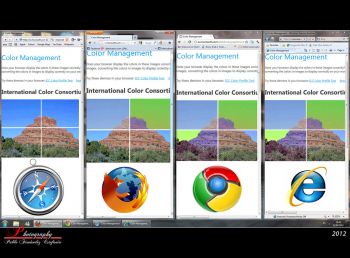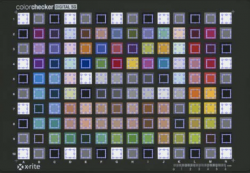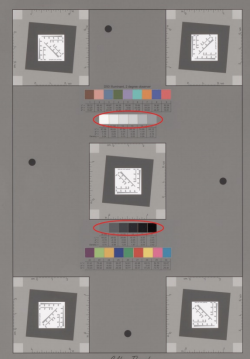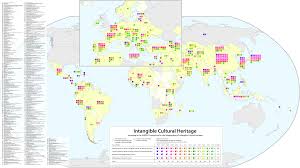International Color Consortium (ICC) Color Management System
Background
Color Management

In digital imaging systems, color management is defined as the controlled conversion between the color representations of various devices, including, but not limited to, image scanners, digital cameras, monitors, TV screens, film printers, computer printers, and offset presses. The purpose of color management is to achieve a good match of appearance across color devices in situations wherein devices are capable of delivering the needed color intensities. With digital preservation of photographic cultural heritage materials, it is often deemed necessary by federal or local guidelines that the available prints or online gallery photographs appear the way that they were intended in the original production. While color management protocols cannot guarantee identical color reproduction, their proper execution can serve to provide more control over any unwanted changes which may occur in the digitization and reproduction process.
Defining the ICC Color Management System
Color management technology has a variety of components that pertain to the operating system (OS), helper libraries, the application itself, and devices. Given the diversity of sources and methods for color management systems, a cross-platform view of color management given by the use of an ICC-compatible color management system is the industry standard.
The International Color Consortium (ICC) is an industry consortium that has defined: (1) an open standard for a Color Matching Module (CMM) at the OS level, and (2) color profiles for both devices, including devicelink-profiles (these represent a complete color transformation from the source device to the target device), and for working spaces (the color spaces in which color data is meant to be manipulated).
Aside from using ICC profiles, there are other approaches to color management, as needs in color management often differ from those in the ICC standard covers. For example, the film and broadcasting industries use overlapping concepts. However, they typically require so-called “boutique” solutions to color management that are limited in application. One such example can be found in the film industry, which often uses LUTs (lookup tables) in order to represent a complete color transformation for a specific RGB encoding. For general consumer graphics and display, color management is largely in the works, as the ICC standards and technologies are commonly confined to still images rather than videos.
Methods
iccMAX
The iccMAX is a next-generation color management architecture developed by the International Color Consortium with significantly expanded functionality and an added choice of colorimetric, spectral, or material connection space.
OpenDICE
OpenDICE software is an open license solution for digital imaging quality assessment outlined in the FADGI (Federal Agencies Digitization Guidelines Initiative) specifications. Digital imaging quality assessment criteria in OpenDICE is centered around evaluation of the image quality in three major categories: tone scale, color accuracy, and resolution analysis. The OpenDICE software currently supports twelve commercially available targets, and will soon support new targets that are currently under development. There have been two versions of the software developed, one for individual image quality analysis, which offers user interaction to control the assessment criteria, and the other for batch image processing, which collects the assessment results for statistical analysis. OpenDICE has become globally relevant, but is still emerging, as ten different countries are now using OpenDICE for their digitization jobs.
Sampling Frequency

This parameter measures the imaging spatial resolution, and is computed as the physical pixel count in pixels per inch (ppi), pixels per mm, etc. This parameter informs us about the size of the original and also provides part of the data needed to determine the level of detail recorded in the file.
Tone Response (Opto-Electronic Conversion Function)

Opto-Electronic Conversion Function (OECF) is a measure of how accurately the digital imaging system converts light levels into digital pixels.
White Balance Error
This is a measurement of the color neutrality of the digital file. Ideally, an image of a white reflective object would be recorded digitally as even values across red, green and blue channels, with a value approaching the limit of the file format to define white.
Illuminance Non-uniformity
Both lighting and lens performance contribute to this measurement. Ideally, there should be a perfectly even recording of a neutral reference from center to edge and between points within the image.
Color Accuracy
There is no perfect imaging system or perfect method of color evaluation. Color accuracy is measured in DICE by computing the color difference (ΔE2000) between the imaging results of the standard target patches and their pre-measured color values. By imaging the DICE target and evaluating through the DICE software, variances from known values can be determined, which is a good indicator of how accurate the system is recording color. DICE measures the average deviation of all color patches measured (the mean).
Color Channel Mis-Registration
All lenses focus red, green, and blue light slightly imperfectly. This parameter measures the spread of red, green, and blue light in terms of pixels of mis-registration. This parameter is used in the evaluation of lens performance.
Modulation Transfer Function (MTF) and Spatial Frequency Response (SRF)
Modulation Transfer Function is a measurement of the contrast difference between the original image and the digital image. MTF is defined as the modulation ratio of the output image and the ideal image. Spatial Frequency Response measures the imaging systems ability to maintain contrast between increasingly smaller image details. Using these two functions, an accurate determination of resolution can be made as it relates to sampling frequency.
Sharpening
Almost all digital imaging systems apply sharpening, often at a point where the user has no control over the process. Sharpening artificially enhances details to create the illusion of greater definition. DICE testing quantifies the level of sharpening present. There are three major sharpening processes in a typical imaging pipeline: capture sharpening (through camera setting adjustment), image sharpening in post processing, and output sharpening for print or display purposes. Sharpening is usually implemented through image edge enhancement, such as filtering techniques using unsharp masks and inverse image diffusion.
Noise
Digital images contain artifacts that do not relate to the original image, in much the same way that photographic film grain did not relate to the original scene. There are many sources for digital image noise. DICE measures all visible noise and provides a single measurement value.
Applications: Digitizing Cultural Heritage Materials and Global Significance

Digitization enables archives and museums to convert their analog materials into digital formats. UNESCO offers a definition of digitization that connects it to the wider context of the decisions and activities of memory institutions:
"Digitization is the creation of digital objects from physical, analogue originals by means of a scanner, camera or other electronic device. It is undertaken as part of a process that includes: selection, assessment, including of needs, prioritization, preparation of originals for digitization, metadata collection and creation, digitization and creation of data collections, submission of digital resources to delivery systems and repositories. This process is accompanied along the way by management, including intellectual property rights management and quality control, and evaluation at the end."
The techniques developed by the International Color Consortium (ICC), iccMAX and OpenDICE, provide solutions to preservation of cultural heritage items (those with textual and visual components in particular) that allow for viewing the works in a state closest to the one in which they were intended to be viewed. As UNESCO and other agencies detail, ethical issues come into play when considering digital preservation and color management. For example, indigenous communities have been using digitization to regain control over traditional cultural knowledge that is excessively commercialized and used without the consent of the communities where it originated. The World Intellectual Property Organization (WIPO) has encouraged indigenous communities to digitize their intangible heritage, since these items are not protected by conventional intellectual property systems. Such intangible heritage items that have been recorded by researchers and have also appeared in the collections of archives, libraries, and museums. However, the digitization, selection, and arrangement of these materials, often conflicts with the priorities and needs of indigenous communities. iccMAX and OpenDICE, among other techniques developed by the International Color Consortium (ICC), are at the forefront of the new digital age, and are beginning to be implemented in smaller collections, rather than only in federal-run ones. Guidelines governing their use have been constructed with the intent of better preserving the heritage collections of indigenous communities in their original forms.
Resources for Cultural Heritage Digital Preservation and Color Management
1. Theory into Practice (Cornell University Library)
3. NDLP Project Planning Checklist (Library of Congress)
References
1. “2015 National Agenda Executive Summary.” Accessed December 5, 2020. http://www.digitalpreservation.gov/documents/2015NationalAgendaExecSummary.pdf.
2. “Digital Preservation Handbook.” Accessed December 5, 2020. https://www.dpconline.org/handbook.
3. Diversity of Cultural Expressions. “Policies for Digitalization of Cultural Heritage,” December 12, 2016. https://en.unesco.org/creativity/policy-monitoring-platform/policies-digitization-cultural.
4. Levy, Trudy. “Moving Theory into Practice: Digital Imaging for Libraries and Archives.” Journal of Documentation 59, no. 4 (January 1, 2003): 497–98. https://doi.org/10.1108/00220410310485857.
5. “NDLP Project Planning Checklist.” Accessed December 10, 2020. https://memory.loc.gov/ammem/prjplan.html.
6. Puglia, Steven, Jeffrey Reed, and Erin Rhodes. “Technical Guidelines for Digitizing Cultural Heritage Materials,” September 2016, 99. http://www.digitizationguidelines.gov/guidelines/FADGI%20Federal%20%20Agencies%20Digital%20Guidelines%20Initiative-2016%20Final_rev1.pdf
7. United Nations Educational, Scientific and Cultural Organization (UNESCO), “Fundamental Principles of Digitization of Documentary Heritage,” UNESCO.org, accessed February 11, 2017, http://www.unesco.org/new/fileadmin/MULTIMEDIA/HQ/CI/CI/pdf/mow/digitization_guidelines_for_web.pdf.
Back to Remote Book History Resources.